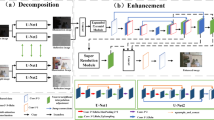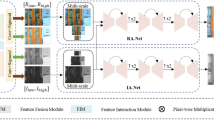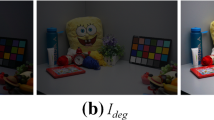Abstract
Images captured under low-light conditions often suffer from severe loss of structural details and color; therefore, image-enhancement algorithms are widely used in low-light image restoration. Image-enhancement algorithms based on the traditional Retinex model only consider the change in the image brightness, while ignoring the noise and color deviation generated during the process of image restoration. In view of these problems, this paper proposes an image enhancement network based on multi-stream information supplement, which contains a mainstream structure and two branch structures with different scales. To obtain richer feature information, an information complementary module is designed to realize the information supplement for the three structures. The feature information from the three structures is then concatenated to perform the final image recovery operation. To restore more abundant structures and realistic colors, we define a joint loss function by combining the L1 loss, structural similarity loss, and color-difference loss to guide the network training. The experimental results show that the proposed network achieves satisfactory performance in both subjective and objective aspects.





Similar content being viewed by others
References
Afifi, M., Derpanis, K. G., Ommer, B., & Brown, M. S. (2021). Learning multi-scale photo exposure correction. In Proc. IEEE int. conf. comput. vision pattern recognit. (pp. 9157–9167).
Dong, X., Wang, G., Pang, Y., Li, W., Wen, J., Meng, W., & Lu, Y. (2011). Fast efficient algorithm for enhancement of low lighting video. In Proc. IEEE int. conf. multimedia expo. (pp. 1–6).
Duc, T., Dang, N., Cecilia, P., Valentina, C., & Giulia, B. (2015). Raise: a raw images dataset for digital image forensics. In Proc. 6th ACM multimedia syst. conf. (pp. 219–224).
Fu, X., Zeng, D., Huang, Y., Liao, Y., Ding, X., & John, P. (2016). A fusion-based enhancing method for weakly illuminated images. Signal Processing, 129, 82–96.
Guo, X., Li, Y., & Ling, H. (2017). LIME: Low-light image enhancement via illumination map estimation. IEEE Transactions on Image Processing, 26(2), 982–993.
Guo, Y., Ke, X., Ma, J., & Zhang, J. (2019). A pipeline neural network for low-light image enhancement. IEEE Access, 7, 13737–13744.
Jiang, Y., Gong, X., Liu, D., Cheng, Y., Fang, C., Shen, X., Yang, J., Zhou, P., & Wang, Z. (2021). EnlightenGAN: Deep light enhancement without paired supervision. IEEE Transactions on Image Processing, 30, 2340–2349.
Jobson, D. J., Rahman, Z., & Woodell, G. A. (1997a). Properties and performance of a center/surround Retinex. IEEE Transactions on Image Processing, 6(3), 451–462.
Jobson, D. J., Rahman, Z., & Woodell, G. A. (1997b). A multiscale Retinex for bridging the gap between color images and the human observation of scenes. IEEE Transactions on Image Processing, 6(7), 965–976.
Ko, S., Yu, S., Kang, W., Park, C., Lee, S., & Paik, J. (2017). Artifact-free low-light video enhancement using temporal similarity and guide map. IEEE Transactions on Industrial Electronics, 64(8), 6392–6401.
Land, E. H. (1977). The Retinex theory of color vision. Scientific American, 237(6), 108–128.
Lee, H., Sohn, K., & Min, D. (2020). Unsupervised low-light image enhancement using bright channel prior. IEEE Signal Processing Letters, 27, 251–255.
Li, L., Wang, R., Wang, W., & Gao, W. (2015). A low-light image enhancement method for both denoising and contrast enlarging In Proc. IEEE int. conf. image process. (pp. 3730–3734).
Park, S., Moon, B., Ko, S., Yu, S., & Paik, J. (2017). Low-light image enhancement using variational optimization-based Retinex model. In Proc. IEEE int. conf. consum. electron. (pp. 70–71).
Rao, Y., & Chen, L. (2012). A survey of video enhancement techniques. Journal of Information Hiding and Multimedia Signal Processing, 3(1), 71–99.
Ronneberger, O., Fischer, P., & Brox, T. (2015). U-net: Convolutional networks for biomedical image segmentation. In Proc. IEEE int. conf. medical image comput. comput.—Assisted intervention (pp. 234–241).
Sharma, G., Wu, W., & Dalal, E. (2005). The CIEDE2000 color-difference formula: Implementation notes, supplementary test data, and mathematical observations. Color Research and Application, 30(1), 21–30.
Sujee, R., & Padmavathi, S. (2017). Image enhancement through pyramid histogram matching. In Proc. int. conf. comput. commun. inform. (pp. 1–5).
Tao, L., Zhu, C., Song, J., Lu, T., Jia, H., & Xie, X. (2017). Low-light image enhancement using CNN and bright channel prior. In Proc. IEEE int. conf. image process. (pp. 3215–3219).
Wang, Z., Bovik, A. C., Sheikh, H. R., & Simoncelli, E. P. (2004). Image quality assessment: From error visibility to structural similarity. IEEE Transactions on Image Processing, 13(11), 600–612.
Wang, Z., Simoncelli, E. P., & Bovik, A. C. (2003). Multiscale structural similarity for image quality assessment. In Proc. IEEE conf. rec. 37th Asilomar conf. signals syst. comput. (Vol. 2, pp. 1398–1402).
Wei, C., Wang, W., Yang, W., & Liu, J. (2018). Deep Retinex decomposition for low-light enhancement. In Proc. British mach. vis. conf. (pp. 1–10).
Yang, M., Tang, G., Liu, X., Wang, L., Cui, Z., & Luo, S. (2018). Low-light image enhancement based on Retinex theory and dual-tree complex wavelet transform. Optoelectronics Letters, 14(6), 470–475.
Ying, Z., Li, G., Gao, W. (2017). A bio-inspired multi-exposure fusion framework for low-light image enhancement. arXiv:1711.00591
Yu, S., & Zhu, H. (2019). Low-illumination image enhancement algorithm based on a physical lighting model. IEEE Transactions on Circuits and Systems for Video Technology, 29(1), 28–37.
Yu, X., Luo, X., Lyu, G., & Luo, S. (2017). A novel Retinex based enhancement algorithm considering noise. In Proc. 16th int. conf. comput. inf. sci. (pp. 649–654).
Zhang, Y., Zhang, J., & Guo, X. (2019). Kindling the darkness: A practical low-light image enhancer. In Proc. ACM multimedia. (pp. 1632–1640).
Acknowledgements
This work is supported by the National Natural Science Foundation of China (Nos. 61862030 and 62072218), by the Natural Science Foundation of Jiangxi Province (Nos. 20182BCB22006, 20181BAB202010, 20192ACB20002, and 20192ACBL21008), and by the Talent project of Jiangxi Thousand Talents Program (No. jxsq2019201056).
Author information
Authors and Affiliations
Corresponding author
Additional information
Publisher's Note
Springer Nature remains neutral with regard to jurisdictional claims in published maps and institutional affiliations.
Rights and permissions
About this article
Cite this article
Yang, Y., Hu, W., Huang, S. et al. Low-light image enhancement network based on multi-stream information supplement. Multidim Syst Sign Process 33, 711–723 (2022). https://doi.org/10.1007/s11045-021-00812-w
Received:
Revised:
Accepted:
Published:
Issue Date:
DOI: https://doi.org/10.1007/s11045-021-00812-w




